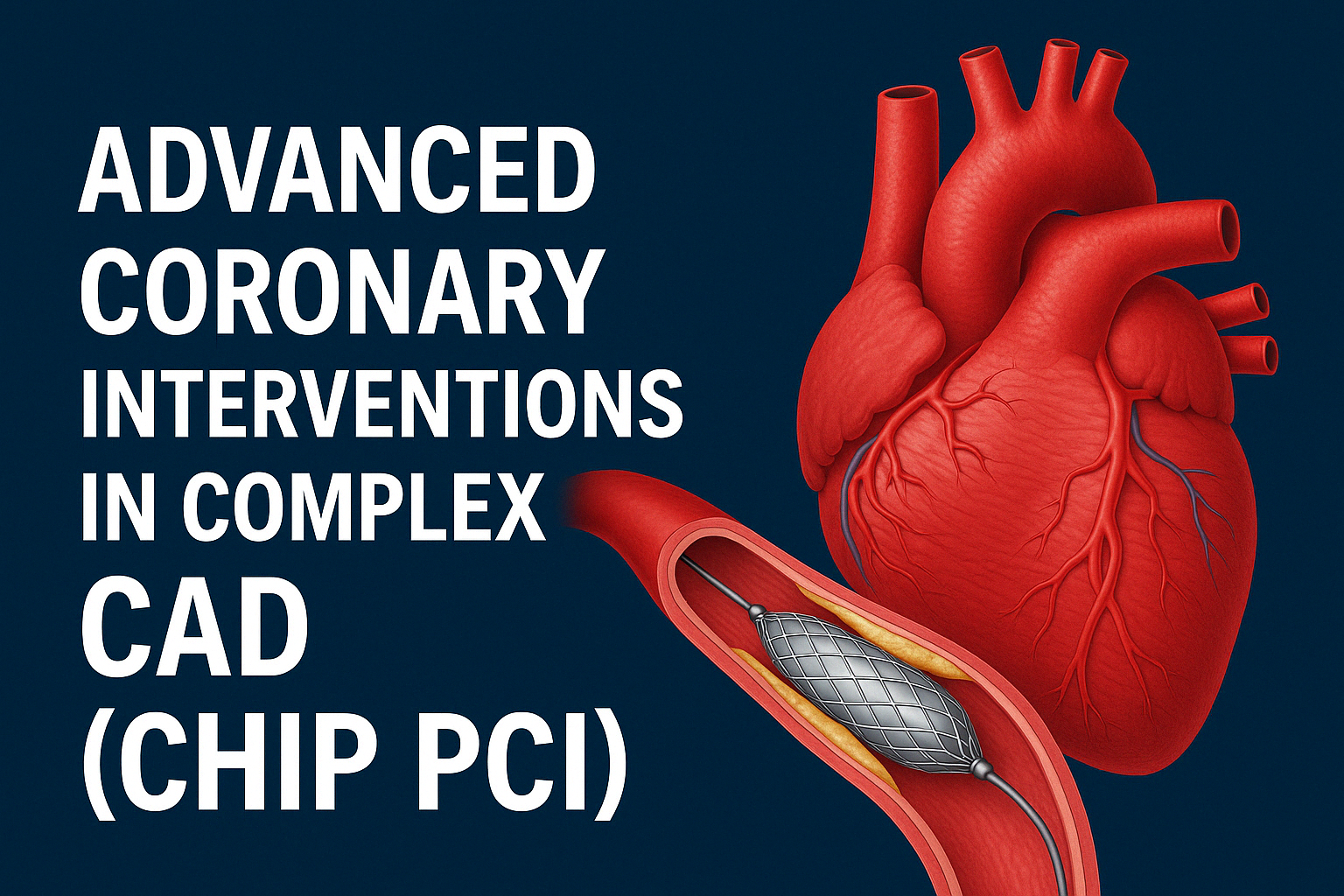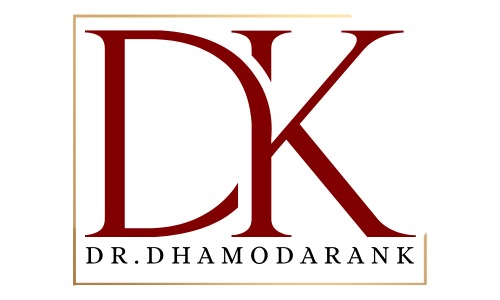 21 April, 2025
21 April, 2025
Advanced Coronary Interventions in Complex CAD (CHIP PCI)
Introduction
Coronary artery disease (CAD) continues to be one of the leading causes of death worldwide. While standard percutaneous coronary interventions (PCI) have drastically improved outcomes for many patients, there remains a subset of individuals who present with more complex disease—either due to anatomy, comorbidities, or previous interventions. These cases, often categorized under Complex High-risk Indicated Percutaneous Coronary Intervention (CHIP PCI), require a different level of strategy, technology, and expertise.
What is CHIP PCI?
CHIP PCI stands for Complex High-risk Indicated PCI, a subset of interventional cardiology dedicated to managing patients with:
-
Severely calcified coronary arteries
-
Chronic total occlusions (CTOs)
-
Left main disease
-
Multivessel disease
-
Cardiogenic shock or severe heart failure
-
Previous bypass surgery with degenerated grafts
These patients are often considered too high-risk for surgery or are not suitable candidates for coronary artery bypass grafting (CABG). CHIP PCI offers a lifeline to this population by enabling revascularization where standard PCI might fail.
The Evolving Landscape of CHIP PCI
With advancements in imaging, device technology, and procedural techniques, CHIP PCI has become a viable and increasingly successful approach. Interventions that were once considered too risky or technically impossible are now routinely performed in specialized centers.
Some of the key enablers include:
1. Intravascular Imaging
-
IVUS (Intravascular Ultrasound) and OCT (Optical Coherence Tomography) guide stent sizing, plaque characterization, and ensure optimal stent deployment.
-
Helps reduce complications by visualizing vessel walls in real time.
2. Calcium Modification Techniques
-
Rotational Atherectomy, Orbital Atherectomy, and Intravascular Lithotripsy (IVL) are crucial for treating heavily calcified lesions.
-
They modify the plaque to facilitate better stent delivery and expansion.
3. Mechanical Circulatory Support (MCS)
-
Tools like Impella, Intra-Aortic Balloon Pump (IABP), and ECMO provide hemodynamic support during high-risk PCI.
-
Ensures stability in patients with severely reduced ejection fraction or cardiogenic shock.
4. Chronic Total Occlusion Techniques
-
Dedicated wires, microcatheters, and retrograde approaches now make CTO PCI success rates exceed 85% in experienced hands.
5. Hybrid Approaches
-
Combining percutaneous intervention with surgical strategies when necessary.
-
In some cases, hybrid revascularization strategies involve PCI of specific vessels and CABG for others.
Indications for CHIP PCI
CHIP PCI is not just about anatomical complexity but also considers the patient’s clinical background. Candidates typically include:
-
Patients with reduced left ventricular ejection fraction (<35%)
-
Elderly patients with multiple comorbidities
-
Those with prior CABG where graft failure has occurred
-
Patients in cardiogenic shock
-
Individuals who are inoperable or refuse CABG
-
Multivessel disease with significant ischemia and symptoms
Pre-Procedural Planning
CHIP PCI success heavily depends on comprehensive planning:
-
Heart Team Discussion: Involves interventional cardiologists, cardiac surgeons, imaging experts, and anesthesiologists.
-
Non-invasive Evaluation: Stress testing, echocardiography, CT angiography for roadmap.
-
Risk Stratification: Use of tools like SYNTAX score, STS score, and frailty assessment.
-
Access Strategy: Radial vs femoral access, dual access for imaging or MCS.
-
Support Plan: Preloading with antiplatelets, anticoagulation strategy, and considering MCS.
Real-World Outcomes and Evidence
Several registries and studies have shown improved outcomes in CHIP PCI patients when performed in high-volume centers:
-
PROTECT II Trial: Demonstrated the use of Impella in high-risk PCI resulted in fewer major adverse events than IABP.
-
ROTA-PCI Registry: Showed that even in elderly or frail patients, rotational atherectomy followed by PCI was feasible with good outcomes.
-
CLASP Study: IVL showed favorable results in calcified coronary lesions with lower complications.
With appropriate case selection and expertise, CHIP PCI provides symptomatic relief, improves ejection fraction, and enhances quality of life.
Challenges in CHIP PCI
Despite advancements, several challenges persist:
-
Higher complication rates: Due to patient profile and anatomical challenges.
-
Longer procedural time: Requires patience, stepwise progression, and technical finesse.
-
Increased cost and resource utilization: High-end imaging, atherectomy devices, and MCS are expensive.
-
Steep learning curve: Requires significant training and experience.
The Future of CHIP PCI
As technology evolves, so will the scope of CHIP PCI. We expect to see:
-
AI-guided imaging and procedural planning
-
Robotic-assisted PCI
-
Smaller, more efficient MCS devices
-
Drug-coated balloons and bioresorbable scaffolds for select cases
Additionally, a stronger focus on post-procedural care, including cardiac rehab and medication adherence, will improve long-term outcomes.
Frequently Asked Questions (FAQs)
1. What does CHIP PCI stand for?
CHIP PCI stands for Complex High-risk Indicated Percutaneous Coronary Intervention. It involves treating complex coronary cases that are high-risk either due to anatomy, clinical profile, or surgical ineligibility.
2. Who are the ideal candidates for CHIP PCI?
Ideal candidates include patients with:
-
Severely calcified arteries
-
Chronic total occlusions
-
Left main or multivessel disease
-
Low heart function (ejection fraction <35%)
-
Cardiogenic shock or advanced age with comorbidities
3. Is CHIP PCI safer than surgery for high-risk patients?
In many cases, yes. Especially when surgery poses a higher risk due to age, frailty, or comorbid conditions, CHIP PCI can be a safer and less invasive alternative.
4. What tools are used in CHIP PCI?
Key tools include:
-
Intravascular imaging (IVUS, OCT)
-
Calcium modification devices (rotablation, IVL)
-
Mechanical circulatory support (Impella, IABP)
-
Dedicated CTO wires and catheters
5. What is the success rate of CHIP PCI?
In experienced centers, the success rate can exceed 85–90%, depending on lesion complexity and the operator’s expertise.
6. What are the potential risks?
Risks include:
-
Perforation
-
Stroke or embolism
-
Bleeding
-
Arrhythmias
-
Contrast-induced kidney injury
These are minimized in high-volume centers with experienced operators.
7. How long does a CHIP PCI procedure take?
It can take anywhere from 1 to 3 hours or longer, depending on the complexity. Some procedures may require staging.
8. Can CHIP PCI improve heart function?
Yes, especially in patients with ischemic cardiomyopathy. Revascularization can improve myocardial perfusion, reduce angina, and sometimes improve ejection fraction.
 +91 96001 07057
+91 96001 07057 Sidharam Heart Clinic Adyar, Gandhi Nagar, Canal Bank Road, Opp.St.Louis School, Adyar, Chennai, Tamil Nadu 600020
Sidharam Heart Clinic Adyar, Gandhi Nagar, Canal Bank Road, Opp.St.Louis School, Adyar, Chennai, Tamil Nadu 600020
